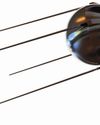Denemek ALTIN - Özgür
A Vista of 100 Billion Flares: Photos From the James Webb Telescope
Innovation & Tech Today
|Volume 8 / Issue 3
If there's one reason to smile It's when you look up out at night You're fortunate enough To drink in a vista 100 billion flares Display a glowing history Splayed out across a canvas, the night sky But, for a moment just contemplate When looking up, you only saw a blank slate And, for a moment just contemplate It appears that heaven's been abandoned -Rou Reynolds

On those cloudy summer nights when light can't penetrate the mass of liquid droplets, frozen crystals and other particles suspended in the atmosphere, consider taking a look at the latest James Webb Space Telescope (JWST) images. They give us an unprecedented view into the ethereal realm of the cosmos beyond our Pale Blue Dot- and they're being beamed back to Earth at an impressive rate.
NASA revealed the first five images taken by the new observatory July 12. Streaming live from the Goddard Flight Center in Maryland, scientists presented the photos one by one accompanied by detailed explanations.
A team of over 20,000 engineers and scientists worked over the course of more than 20 years leading up to JWST's launch on Christmas Day, 2021.
Here are the first official images from NASA's newest deep field observatory.
Image 1: Deep Field Photo of a Cluster of Galaxies
We're seeing these galaxies as they looked over 13 billion years ago, around the same time our Sun was born. You can see individual clusters of stars forming and faint red galaxies in the background. These detailed deep-field images are exactly what JWST was designed to capture.
In comparison, the Hubble extreme deep field took two weeks of continuous work to produce a photo with less than half the clarity of this one.
"With Webb, we took that image before breakfast," said operations project scientist Jane Rigby.

Image 2: Exoplanet
Bu hikaye Innovation & Tech Today dergisinin Volume 8 / Issue 3 baskısından alınmıştır.
Binlerce özenle seçilmiş premium hikayeye ve 9.000'den fazla dergi ve gazeteye erişmek için Magzter GOLD'a abone olun.
Zaten abone misiniz? Oturum aç
Innovation & Tech Today'den DAHA FAZLA HİKAYE

Innovation & Tech Today
Acting and AI
Hollywood Legend William H. Macy on the Challenges of Quickly-Changing Technology
15 mins
Volume 9 / Issue 4

Innovation & Tech Today
New Mexico: A Rising Tech Hub
Explosive Growth Driven by Strategic Investments and Innovation
2 mins
Volume 9 / Issue 4

Innovation & Tech Today
Robots and Space Exploration
From Mars Rovers to Beyond
3 mins
Volume 9 / Issue 4

Innovation & Tech Today
Charting New Territories
The Beginning of Robotization with Cobots
2 mins
Volume 9 / Issue 4

Innovation & Tech Today
AI and Design
Is The Art World Embracing Al?
3 mins
Volume 9 / Issue 4

Innovation & Tech Today
Behind the Scenes of the Netflix Film Spaceman
Exclusive Interview with Director John Renck
4 mins
Volume 9 / Issue 4

Innovation & Tech Today
Autonomous Robotics
Are Delivery Bots Getting Bigger?
2 mins
Volume 9 / Issue 4

Innovation & Tech Today
A World of Limitless Innovations
The Next Big Things In Consumer Tech—Direct From McHenry, Illinois
4 mins
Volume 9 / Issue 4

Innovation & Tech Today
The Rise of Smart Home Furniture
Merging Comfort With Technology Like Never Before
2 mins
Volume 9 / Issue 4

Innovation & Tech Today
The Next Generation of Smart Homes
A Glimpse into the Future of Residential Tech
4 mins
Volume 9 / Issue 4
Translate
Change font size
